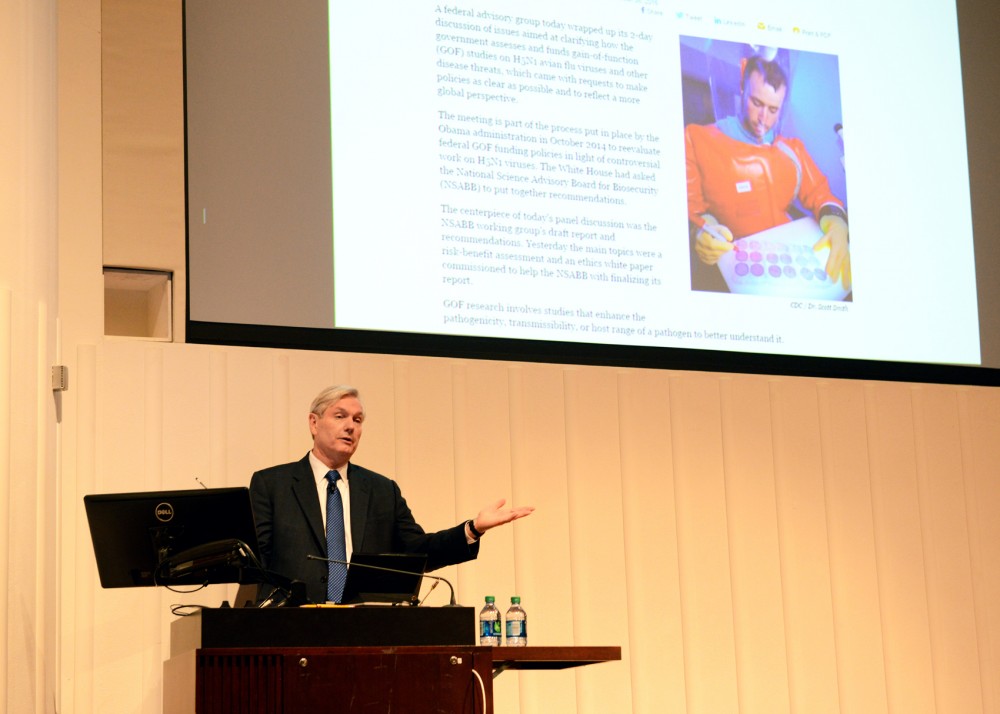In a small, first-floor office on the University of Minnesota campus, Jill DeBoer plans for worst-case scenarios.
DeBoer, the director of the Academic Health Center’s Office of Emergency Response, has bookshelves holding binders filled with detailed response plans — “playbooks” — for every disease that has been a threat to students since the team organized in 2004.
DeBoer said similar groups formed nationwide after the anthrax attacks following 9/11, but those groups have shifted in recent years to prepare for more than bioterrorism — be it a case of meningitis on campus, a bridge collapse or something that hasn’t yet been seen.
The AHC-OER is now forming a Zika virus playbook, DeBoer said. The team has sent information and travel warnings to all University students studying in affected countries.
“The first partner we call is the GPS Alliance because often these infectious disease issues start off in other countries, and so with H1N1, with Ebola, with Zika, that’s our first call,” DeBoer said.
There’s a specially tailored response team for every scenario, she said. The size of the team varies with the scope of the threat, ranging from a handful of people to more than 50. Each team member has two backups.
DeBoer said the AHC-OER works with the Minnesota Department of Health — which has its own emergency team — and monitors the spread of diseases around the world.
“We have to be prepared for anything,” she said. “I feel our response system should be able to coordinate and
respond to almost anything.”
School of Public Health and Medical School professor Michael Osterholm, who is also the director of the University’s Center for Infectious Disease Research and Policy, addressed global infectious disease preparedness in a lecture last week.
“The next pandemic is going to happen,” he said at the talk. “It could happen tomorrow; it could be happening today.”
Osterholm said no group is ready for the next pandemic because global systems are disjointed and broken.
“There are so many holes in this ship,” he said at the lecture. “Even if we bail it out as much as we can with all our strength, we might still be sinking.”
Osterholm said influenza is the biggest threat, and when — not if — an outbreak happens in Minnesota, there won’t be enough vaccines to go around, he said.
“Today, many of our key drug producers are offshore. If we have a pandemic that interrupts travel and trade, that will be a challenge,” he said. “I don’t care how prepared you are at a state level, if you have a vaccine or not makes all the difference.”
University biochemistry junior Melanie Raphael attended the lecture and said she was worried that people know too little about the importance of vaccines.
She said college students lack awareness of diseases that threaten other parts of the world.
“It took me a while to even hear about [the Zika virus],” Raphael said. “Here in college, we are kind of isolated from the rest of the world.”
Infectious diseases can come to the U.S. from other parts of the world through travel, like what’s happened with the Zika virus, said MDH infectious disease epidemiologist Richard Danila.
“We are always on the lookout for the next big event, whether that’s an influenza virus or a pandemic like Zika,” he said.
When a new disease makes headlines, it’s hard for scientists to prevent misinformation in the media, Danila said.
MDH strategically shares information with Minnesotans to control panic due to bad information, said Cheryl Petersen-Kroeber, deputy director of MDH Emergency Preparedness and Response.
“Epidemiologists base their decisions on the science they have at the time,” Petersen-Kroeber said. “Sometimes it’s hard because the science is always changing.”


